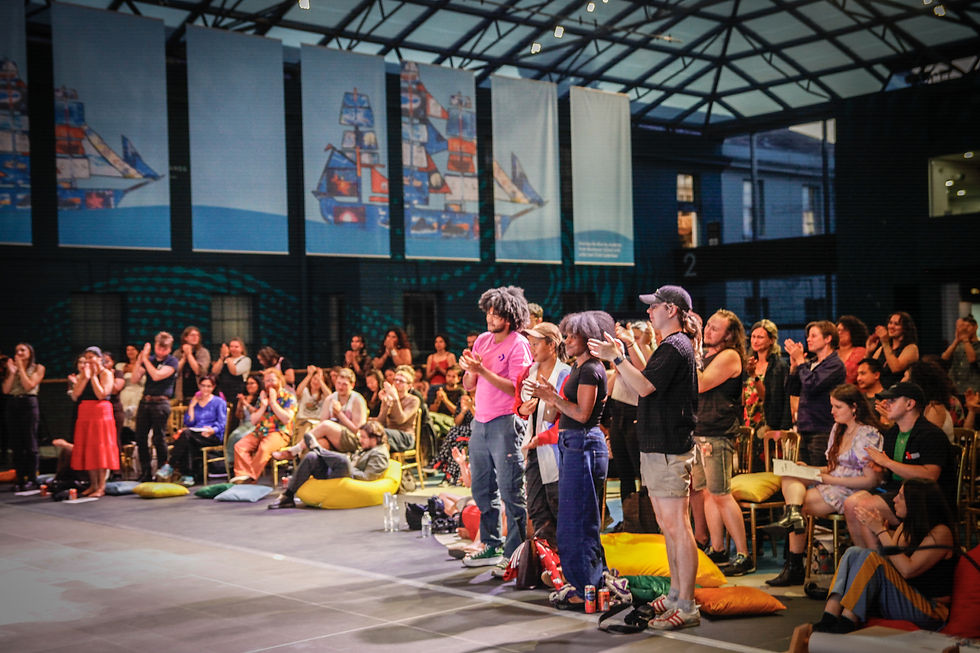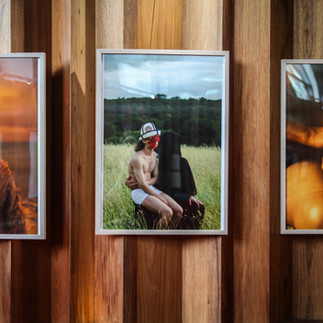Inside-Out: Queer Migrations Across Rooms, Oceans, and Histories
- Veronica Revuelta Garrido
- Aug 14
- 4 min read
I hadn’t heard of Firepit Art Gallery & Studios before, but stepping inside was like walking into a set where 1960s cool collides with David Lynch’s strange dream logic, with just a touch of vintage adult cinema. The space has a presence: bold, atmospheric, impossible to ignore. At first, I wondered if it might swallow the art. But community takes time, making art takes time, conversations take time.

Emilia Nurmukhamet from Bold Mellon Collective offered me a thoughtful insight by picking the works in the order I wanted, and with it came the chance to ask everything, from the migration stories behind the works to the personal histories that ripple through the festival’s theme. Suddenly the gallery shifted: sofas appeared, the coffee machine murmured, and people settled in to talk, work, read tarot cards (yes, that happened), or simply sit with the art. The exhibition, like the space, was open and generous, personal yet international, intimate yet expansive, sometimes raw, sometimes gentle, but intentional.
Certain works stayed with me: Lenka Kalafutova’s antique-like vessels that carried a sense of timeless fragility, Nat Sultan’s photographs at dawn capturing the in-between light where nothing is fully settled, and Misha Zakharov’s decolonial perspectives on Central and Eastern Europe, the Caucasus, Central Asia and Maghreb region through film and writing. However, all the works connect with each other; they dialogue, communicate, challenge. Within each other’s practices, visually, like having a chit-chat on those sofas: Tasalla Tabasom’s textiles, bold yet quiet in their language of identity and migration, the layered narratives in Zakharov’s Open Bodies-Cold Lands, Yaya’s oceanic portraits, Rishi Khurana’s sculptural paintings, Elisia Brown’s digital collages, Elvira Pushkareva’s rights-based paintings, and Lapis Al-Shammaa’s pomegranate-stained memories.
Photo credit: Amy-Rose Edlyn
There was no fixed path to follow. You start with what calls to you, and from there, the whole thing unfolds. In Global Mobilities terms, this is the soft, everyday kind of movement, the drift from work to work, conversation to coffee, a way of inhabiting space that feels completely at odds with the controlled, pre-set paths of traditional exhibitions. In its openness, Bold Mellon Collective was already queering the exhibition form, refusing a single fixed route or voice, and instead making space for drift, for chance encounters, for multiple narratives to coexist without hierarchy.
Later, the festival moved to the National Maritime Museum, Royal Museums Greenwich for a live art performance event, an ambitious, deeply symbolic choice. To queer and decolonise a national museum is no small act, especially in the UK, where many collections are rooted in empire and colonisation. I know how resistant these spaces can be to change. National museums are often built to hold objects still, to freeze them in time and place, even when those very objects come from histories of movement, exchange, and displacement. Things are changing but there is still a lot to do to decolonise those objects and take them out of the closet.
The event took place in the Ocean Court, where vast ocean maps stretch across the floor. It was a perfect meeting point, the same oceans that have carried migration and displacement, but also connection and exchange. Performances unfolded across them: Abel Atsede’s Bichu, a solo dance threaded with poetry and drawn from his lived experience as a queer refugee; Chen Xu’s A Museum of Ellipses, a moving blend of installation, narration, and movement, mapping their migration story against Britain’s colonial maritime history; Oscar Rodriguez’s My Only Last Destination, weaving soundscapes and poetry of Salvadoran migration; and Emilia Nurmukhamet’s Weight of Waiting, a quiet dance with the sea, anchored by the straightforward voice and the memory of her grandmother’s temple. Each work was deeply personal, reframing the space with presence rather than quiet deference, restoring motion to a place designed to keep history still.
Photo credit: Amy-Rose Edlyn
This was more than a performance night. The collective worked with the museum’s archives, ran workshops, and presented artworks created by the community at the Firepit gallery, because why not? Greenwich became louder, bolder, funnier, queerer, and more activist in spirit. This is what socially engaged practice can look like: art that doesn’t just speak to people but works with them, creates with them, and hands over the mic. In doing so, it shifted the curatorial frame from above to below, from an institutional narrative to a lived one.
Both spaces, Firepit and the Ocean Court, carried a tension between what is inherited and what is possible. The festival used art not as decoration, but as a way of making presence felt, of shifting who gets to be seen and heard. Whether through intimate works in a retro corner of Greenwich Peninsula or bold performances on the imperial maps of Greenwich, it invited us to think about migration, belonging, and the power of taking space.
























Comments